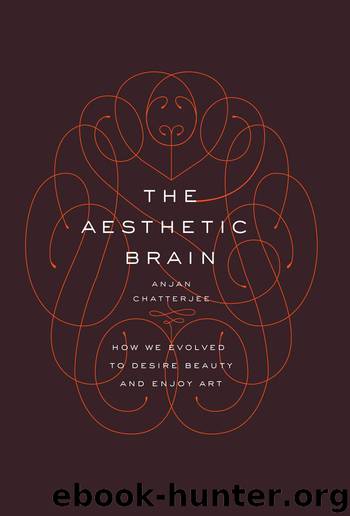The Aesthetic Brain by Anjan Chatterjee

Author:Anjan Chatterjee,
Language: eng
Format: epub
Publisher: Oxford University Press, USA
Published: 2014-09-22T04:00:00+00:00
Chapter 6
The Logic of Pleasure
All creatures that move, approach the things they need and avoid the things they think will cause them harm. This approach-and-avoidance behavior is the fundamental axis around which more complicated actions get organized. For humans, pleasure fuels much of our approach behavior. Pleasure profoundly affects how we live as individuals and how we evolved as a species. It is the central ingredient of a complex reward system that lets us savor food and sex, find beauty in people and places, and delight in paintings and plays. In this final chapter of the section on pleasure, let’s review some of the highlights of these complex reward systems.
Our reward systems are made up of different components that are necessary for us to experience pleasure and desire. As we have seen, pleasure and desire (or liking and wanting) are not the same thing. Beyond feeling pleasure and desire, some components within our rewards system allow us to anticipate pleasure, to evaluate the pleasures we experience, and to plan actions that get us to the objects of our desires. Still other components of our reward systems modify our pleasures, restrain our approaches, and help us learn.
Our pleasure, at its most basic, is rooted in our appetites for food and sex. Our ancestors who took pleasure in nourishing food and in having sex with healthy partners were the ones who survived and propagated. We inherited their pleasures. Pleasure also helps keep us alive by serving a homeostatic function. Homeostatic functions are processes that regulate our body to stay within a narrow physiological window in which we operate at our best. If we deviate from that window, we need to be brought back in line, and pleasure encourages us to do so. When we are salt deprived, we like super-salty tastes, and when sated, we do not like sweet syrups.
The core experience of pleasure works deep in the brain through the nucleus accumbens and the rest of the ventral striatum. These structures are active regardless of whether pleasure arises from food, sex, or money. The chemical currencies in these neural structures are opioids and cannabinoids working together. The bliss of someone in the midst of an opium or marijuana high is the result of the flooding of their receptors that are bathed more gently when we experience everyday pleasures.
Desires drive us to act. The chemical currency for desire is dopamine. The brainstem sends dopamine to parts of the striatum to motivate us to act on our desires. Other parts of the brain evaluate our pleasures. The medial orbitofrontal cortex and the ventromedial frontal lobes seem to code our pleasures and are probably the brain structures that contribute to our being aware that we are experiencing pleasure. Normally, pleasure and desire work together. We want things that we like and we like things that we want. However, these components can part ways. For addicts, sometimes wanting overwhelms liking as it gets out of control. A question to which we shall return when talking
Download
This site does not store any files on its server. We only index and link to content provided by other sites. Please contact the content providers to delete copyright contents if any and email us, we'll remove relevant links or contents immediately.
| Anthropology | Archaeology |
| Philosophy | Politics & Government |
| Social Sciences | Sociology |
| Women's Studies |
The remains of the day by Kazuo Ishiguro(8754)
Tools of Titans by Timothy Ferriss(8162)
Giovanni's Room by James Baldwin(7122)
The Black Swan by Nassim Nicholas Taleb(6953)
Inner Engineering: A Yogi's Guide to Joy by Sadhguru(6639)
The Way of Zen by Alan W. Watts(6459)
Asking the Right Questions: A Guide to Critical Thinking by M. Neil Browne & Stuart M. Keeley(5582)
The Power of Now: A Guide to Spiritual Enlightenment by Eckhart Tolle(5550)
The Six Wives Of Henry VIII (WOMEN IN HISTORY) by Fraser Antonia(5363)
Astrophysics for People in a Hurry by Neil DeGrasse Tyson(5099)
Housekeeping by Marilynne Robinson(4259)
12 Rules for Life by Jordan B. Peterson(4222)
The Ethical Slut by Janet W. Hardy(4152)
Double Down (Diary of a Wimpy Kid Book 11) by Jeff Kinney(4151)
Skin in the Game by Nassim Nicholas Taleb(4128)
Ikigai by Héctor García & Francesc Miralles(4050)
The Art of Happiness by The Dalai Lama(4014)
Skin in the Game: Hidden Asymmetries in Daily Life by Nassim Nicholas Taleb(3873)
Walking by Henry David Thoreau(3863)
